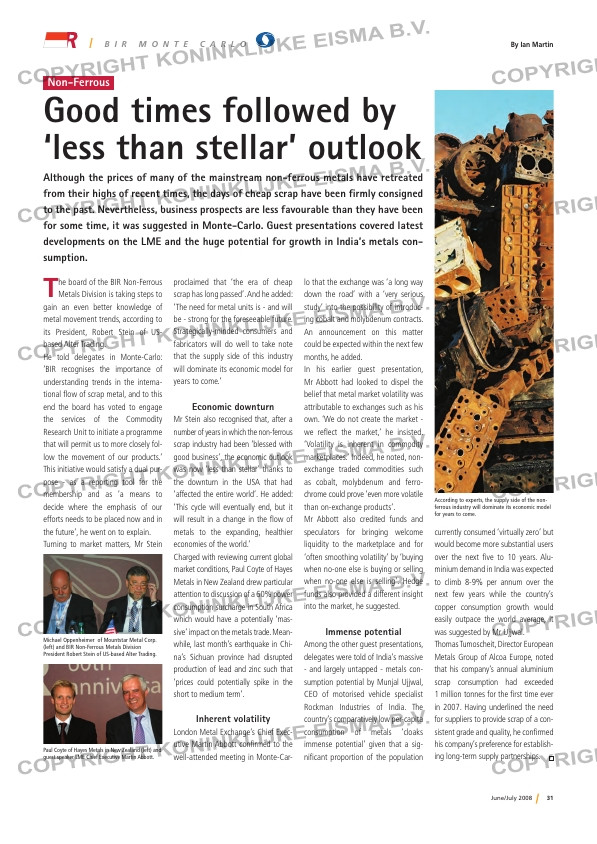Page 31 from: June / July 2008

31June/July 2008
B I R M O N T E C A R L O By Ian Martin
Non-Ferrous
The board of the BIR Non-Ferrous Metals Division is taking steps to
gain an even better knowledge of
metal movement trends, according to
its President, Robert Stein of US-
based Alter Trading.
He told delegates in Monte-Carlo:
‘BIR recognises the importance of
understanding trends in the interna-
tional flow of scrap metal, and to this
end the board has voted to engage
the services of the Commodity
Research Unit to initiate a programme
that will permit us to more closely fol-
low the movement of our products.’
This initiative would satisfy a dual pur-
pose – as a reporting tool for the
membership and as ‘a means to
decide where the emphasis of our
efforts needs to be placed now and in
the future’, he went on to explain.
Turning to market matters, Mr Stein
proclaimed that ‘the era of cheap
scrap has long passed’. And he added:
‘The need for metal units is – and will
be – strong for the foreseeable future.
Strategically-minded consumers and
fabricators will do well to take note
that the supply side of this industry
will dominate its economic model for
years to come.’
Economic downturn
Mr Stein also recognised that, after a
number of years in which the non-ferrous
scrap industry had been ‘blessed with
good business’, the economic outlook
was now ‘less than stellar’ thanks to
the downturn in the USA that had
‘affected the entire world’. He added:
‘This cycle will eventually end, but it
will result in a change in the flow of
metals to the expanding, healthier
economies of the world.’
Charged with reviewing current global
market conditions, Paul Coyte of Hayes
Metals in New Zealand drew particular
attention to discussion of a 60% power
consumption surcharge in South Africa
which would have a potentially ‘mas-
sive’ impact on the metals trade. Mean-
while, last month’s earthquake in Chi-
na’s Sichuan province had disrupted
production of lead and zinc such that
‘prices could potentially spike in the
short to medium term’.
Inherent volatility
London Metal Exchange’s Chief Exec-
utive Martin Abbott confirmed to the
well-attended meeting in Monte-Car-
lo that the exchange was ‘a long way
down the road’ with a ‘very serious
study’ into the possibility of introduc-
ing cobalt and molybdenum contracts.
An announcement on this matter
could be expected within the next few
months, he added.
In his earlier guest presentation,
Mr Abbott had looked to dispel the
belief that metal market volatility was
attributable to exchanges such as his
own. ‘We do not create the market –
we reflect the market,’ he insisted.
‘Volatility is inherent in commodity
marketplaces.’ Indeed, he noted, non-
exchange traded commodities such
as cobalt, molybdenum and ferro-
chrome could prove ‘even more volatile
than on-exchange products’.
Mr Abbott also credited funds and
speculators for bringing welcome
liquidity to the marketplace and for
‘often smoothing volatility’ by ‘buying
when no-one else is buying or selling
when no-one else is selling’. Hedge
funds also provided a different insight
into the market, he suggested.
Immense potential
Among the other guest presentations,
delegates were told of India’s massive
– and largely untapped – metals con-
sumption potential by Munjal Ujjwal,
CEO of motorised vehicle specialist
Rockman Industries of India. The
country’s comparatively low per-capita
consumption of metals ‘cloaks
immense potential’ given that a sig-
nificant proportion of the population
currently consumed ‘virtually zero’ but
would become more substantial users
over the next five to 10 years. Alu-
minium demand in India was expected
to climb 8-9% per annum over the
next few years while the country’s
copper consumption growth would
easily outpace the world average, it
was suggested by Mr Ujjwal.
Thomas Tumoscheit, Director European
Metals Group of Alcoa Europe, noted
that his company’s annual aluminium
scrap consumption had exceeded
1 million tonnes for the first time ever
in 2007. Having underlined the need
for suppliers to provide scrap of a con-
sistent grade and quality, he confirmed
his company’s preference for establish-
ing long-term supply partnerships.
Although the prices of many of the mainstream non-ferrous metals have retreated
from their highs of recent times, the days of cheap scrap have been firmly consigned
to the past. Nevertheless, business prospects are less favourable than they have been
for some time, it was suggested in Monte-Carlo. Guest presentations covered latest
developments on the LME and the huge potential for growth in India’s metals con-
sumption.
According to experts, the supply side of the non-
ferrous industry will dominate its economic model
for years to come.
Good times followed by
‘less than stellar’ outlook
Paul Coyte of Hayes Metals in New Zealand (left) and
guest speaker LME Chief Executive Martin Abbott.
Michael Oppenheimer of Mountstar Metal Corp.
(left) and BIR Non-Ferrous Metals Division
President Robert Stein of US-based Alter Trading.
RI_014 BIR Non-Ferrous.indd 31 19-06-2008 11:17:07



